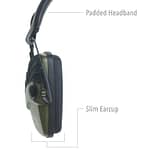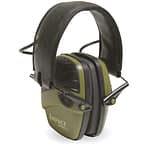Hearing loss is a subtle loss of hearing over time and usually goes unnoticed for many years. This is why you must minimize any damage at every opportunity. Electronic earmuffs are an excellent product to serve just that purpose. So here’s how electronic ear muffs work.
To better understand how electronic ear muffs work, let us break it down and look at how electronic ear muffs work. Where and why you should use them. A note on ratings, comfort, and pricing.
Electronic ear muffs automatically amplify sounds under a defined decibel level while simultaneously muffling loud sounds like gunshots. The electronic microphones pick up and amplify sound at a lower level db like a conversation. You can amplify even the sound your quarry makes. Microphones pick up sound from outside the ear muffs and transfer the sound back into the muffs. Electronic ear muffs work to reduce (or eliminate) dangerously loud sounds.
Table of Contents
How do they work
As mentioned earlier, electronic muffs are fitted with a microphone and amplifiers that automatically switch off at the set db level. When the db sound level goes above the set level, the microphone shuts off automatically. An amplifier then makes low-volume sounds in the environment easier to hear with the muffs on than with the uncovered ear. Speakers project the amplified sounds to your ear from the inside of the earmuffs.
Some models cut out all the sound when levels reach a certain point, but newer, more advanced models can filter out only the loud sound. These are not completely blocked out but are muffled to a comfortable level. With regular earmuffs, everything is muffled, making it hard to hear someone speaking. When you need to hear others speaking, the ear muffs serve the purpose.

They filter out above a certain sound db level so you can still hear a conversation and protect your ears from loud damaging noise. When turned off, they serve the purpose of regular earmuffs. Some earmuffs will even cut off the sound of a pistol slide closing and may be sensitive enough to muffle out the sound of a twig snapping under your foot.
Why you should use them
Try to imagine living your golden years, not being able to hear. Many people suffer from this condition, but if you can do anything to prevent this, it would absolutely make sense to do it. Electronic ear muffs for anyone exposed to loud noise are certainly going to be a wise decision.

Electronic muffs are often adjustable sometimes; even individual ear cups have settings. This would come in handy if you’re at the range or need to listen to other commands or instructions. It is complicated to judge the noise level by simply listening. Accurately measuring can only really be done with a good quality DB meter. A 2db increase is double the sound to the human ear. Sound levels over 85db from the front and 120db at the back can cause permanent cochlear damage. At 140db, you are almost guaranteed to do damage. A shotgun or SLR produces about 140db, 12g 165db, and 3006 puts out 170db of sound, so you should ensure maximum protection in all of these cases.
Every time you are exposed to these high levels of sound, you are doing damage to your ears without proper protection. This damage, compounded over the years, can do irreparable damage. This may not be noticeable at first, but it can leave you with a debilitating condition in the long run. Insufficient or low-grade protection can still result in tinnitus. Just whatever you do, use something because even tinnitus gets irritating after the first week.
Where you should use them
A pair with a 22db rating is perfect for 22 and 22 pistols—a 25db rating for big pistols and small rifles like AR-15. And 28db-30db for big rifles like 300Win Mag etc.
For clays, earmuffs are ideal. They have the bonus of keeping your ears warm. It goes without saying that correct use and setting determine just how effective they end up being.

The more advanced ear muffs have “smart” capabilities, allowing original loud sounds to come through the muffs at a safe listening volume. In other words, filtering out a sound that could cause damage. Different models come with different speeds at which the amplifier can switch between its “off” and “on” states, in turn affecting a shooter’s accuracy. This can affect the wearer’s ability to hear what’s going on around them in real time. Compression or passive protection is the process of completely blocking out any sounds above your set db level. Of course, this is not noise-canceling, just a reliance on the ear muff’s natural physical ability to muffle the sound by turning off the amplifier.
National Consumer Center offers you a chance to get a $500 gift card to Amazon. The payouts are quick, and you can use the Gift Card to pay for some of your Amazon products.
Cons

The earmuffs are easier to get on and off but restrict movement when it’s hot though your ears sweat a lot. Muffs get in the way when mounting the gun. They are also weighty and put pressure on your head. Muffs over glasses can break the seal and reduce NRR. Muffs also ensure sound does not enter through the back of the ear, which means maximum protection.

With a variety of sizes on option, you can find a very comfortable pair.
The cranium also transports sound energy, and so a cap or hat helps reduce sound. Checking your ear muffs for deterioration over time is important as it can lead to a reduction in protection which the wearer may be unaware of.
Conclusion
It may seem inconvenient or uncomfortable at times, but this should not deter you from securing your hearing. It would be best if you also were looking for a model with 2 microphones. This gives you directional sensitivity. This ability is a handy feature and provides you with an orientation of direction. But they are often expensive.

